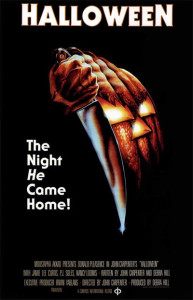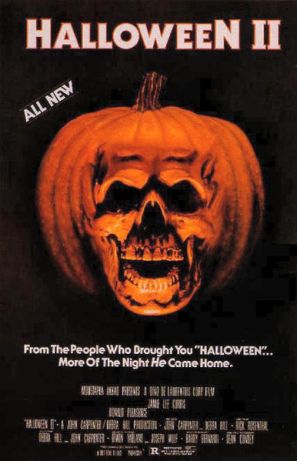 Sheriff Brackett: Every kid in Haddonfield thinks this place is haunted.
Sheriff Brackett: Every kid in Haddonfield thinks this place is haunted.
Dr. Sam Loomis: They may be right.
When I was a kid, there was an old cabin in the woods outside my elementary school. Everyone said the cabin had been owned by a man who married many times; each time he became unhappy with his current wife, he’d chop off her head and put it on a shelf with the heads of the wives that had gone before. Apparently someone had heard the Bluebeard legend and decided to plant a similar tale in our town. But we didn’t know that then; we believed every word of that story. He was our Boogeyman, and we didn’t go into the woods during recess. We knew better.
Halloween and its sequel Halloween II put their own spin on the Boogeyman. This Boogeyman is Michael Myers, locked up in a mental institution after stabbing his sister to death on Halloween night when he was six years old. The house where Michael and his family lived remained empty ever since. Well, until the night HE came home (sorry, but I had to use that line somewhere in this review.) Anyway, Michael comes back home fifteen years after his murderous deed, seeking vice-minded teenagers (and unlucky adults) to add to his body count.
Halloween drove home the consequences of bad behavior better than any lecture my parents could have given me. How could I light up, drink up, or play around? I knew that if I did, some psycho killer would find out about it, and I’d be doomed. Worse, the Boogeyman would get me. And thanks to these films, I knew exactly what was in store for me if he did.
Jamie Lee Curtis (Trading Places, True Lies), plays Laurie Strode, babysitter  extraordinaire and object of Michael’s murderous attention. It’s hard to believe that this is Jamie Lee Curtis’ first movie role; she has an on-screen presence that many actors take years to craft. P.J. Soles (Rock and Roll High School, Stripes), Nancy Kyes (credited in this movie as Nancy Loomis) and John Michael Graham play Laurie’s hormone-addled friends. Although they all seem a bit too old to be playing teenagers, they give themselves up to their roles so completely that you can’t help but be taken along for the ride.
extraordinaire and object of Michael’s murderous attention. It’s hard to believe that this is Jamie Lee Curtis’ first movie role; she has an on-screen presence that many actors take years to craft. P.J. Soles (Rock and Roll High School, Stripes), Nancy Kyes (credited in this movie as Nancy Loomis) and John Michael Graham play Laurie’s hormone-addled friends. Although they all seem a bit too old to be playing teenagers, they give themselves up to their roles so completely that you can’t help but be taken along for the ride.
Brian Andrews plays Tommy Doyle, the little boy who knows better than his babysitter what the Boogeyman is all about. Frightened by his classmate’s taunts, Tommy believes that the Boogeyman is coming. Laurie doesn’t believe him when he first starts seeing strange things outside, but finds out all too soon that Tommy may be right.
Veteran actor Donald Pleasence (THX 1138, The Great Escape) plays Dr. Sam Loomis, a psychiatrist who is the only adult that understands what Michael is capable of. Having battled for years to keep Michael locked away, he heads to Haddonfield to try and stop him. Unfortunately, since most adults no longer believe in the Boogeyman, Dr. Loomis’ warnings aren’t taken very seriously.
This movie still manage to scare me. The idea of an evil force that manages to find you when you are alone, a monster that is completely unstoppable, works on fears installed in every child. In Halloween, the things you think will save you are shown to be useless; dogs can’t protect you, neighbors won’t help you, and authority figures are ineffectual at best. If the Boogeyman wants you, he’ll get you, and there will be no stopping him.
Halloween II picks up where Halloween ends, starting with the aftermath of the first group of murders. Laurie, a survivor of the earlier attacks, is rushed to the hospital. She tries to avoid being sedated, and is scared to go to sleep. She has good reason to be worried; Michael has followed her to the hospital. He stalks her, killing the hospital staff one by one. It’s up to Dr. Loomis to figure out what is going on, before Laurie ends up as the Boogeyman’s next victim.
This sequel is slightly bloodier than its predecessor, perhaps in an attempt to keep up with gorier films like Terror Train and Friday the 13th which had been released after the first film. The body count is higher too. The lighting is used more to keep things hidden than to bring things into the open. The hospital, with its shadowed doors and darkened hallways, imparts a sense of foreboding; you never know what you’re going to see around the next corner. I’ve seen the movie many times and a few scenes still get to me.
My favorite thing about Halloween II is that the characters that come back for this sequel are played by the same actors I saw in the original. One actor even comes back to play a dead body; not a bad casting coup for sequel to a film made three years earlier. Too often sequels try to get by with re-casting characters, hoping the moviegoing public won’t really care. In most horror series, the quality is so low that who’s cast in what role won’t hurt or help the film. But since this story is supposed to have played out during the span of one evening, it’s nice to see continuity. Watching these two films back-to-back makes a nice double feature, and probably improves the sequel. At a little over 3 hours combined, they keep a suspenseful pace, and don’t drag on too long.
As much as I adore Halloween II, I have to admit that this film cannot truly stand on its own. The opening scene of Halloween II replays the ending of the first movie, but it needs the Boogeyman element in order to be a compelling film. Without the back-story, it becomes just another “who’s he gonna kill now” fest. There is no further discussion of Michael’s Boogeyman aspect in the sequel, since the idea of who and what Michael is was almost completely established in the first movie. Michael’s motivation is briefly discussed at the movie’s climax, but it would have been better if they had just left it a mystery. It’s really nothing more than sequel fodder, but thankfully it doesn’t take too much away from the film.
Though these films are typically labeled slasher films, Michael Myers’ relentless pursuit of Laurie Strode causes very little on-screen bloodshed. Director John Carpenter focused instead on watching victims die rather than blood spill, which affected me more than any over-the-top gory effect ever could. The score for both films, a riff on “Tubular Bells” (already creepy due to its use in The Exorcist), manages to convey a sense of deadly urgency. Who knew three notes could sound so ominous? Costuming and art design are dull on purpose; even though the first film tells you the year is 1978 (senseless dating, in my opinion), it has an everyday look that makes it seem timeless. That look is carried over into the sequel, but it’s a whole lot easier to be timeless in a hospital, when just about everyone is wearing a uniform.
If you rent these movies, you may see different versions from the ones they show on television. You’re not seeing things. John Carpenter filmed three additional scenes for the television version of Halloween (replacing more violent content), while Halloween II has edited scenes and alternate endings. But the basic premise is still the same. The Boogeyman is coming, better watch your step.
He could be anywhere. Perhaps where and when you least expect it. Ask the children you know; they’ll tell you.
(Compass International Pictures, 1978) and (Universal Pictures, 1981)
